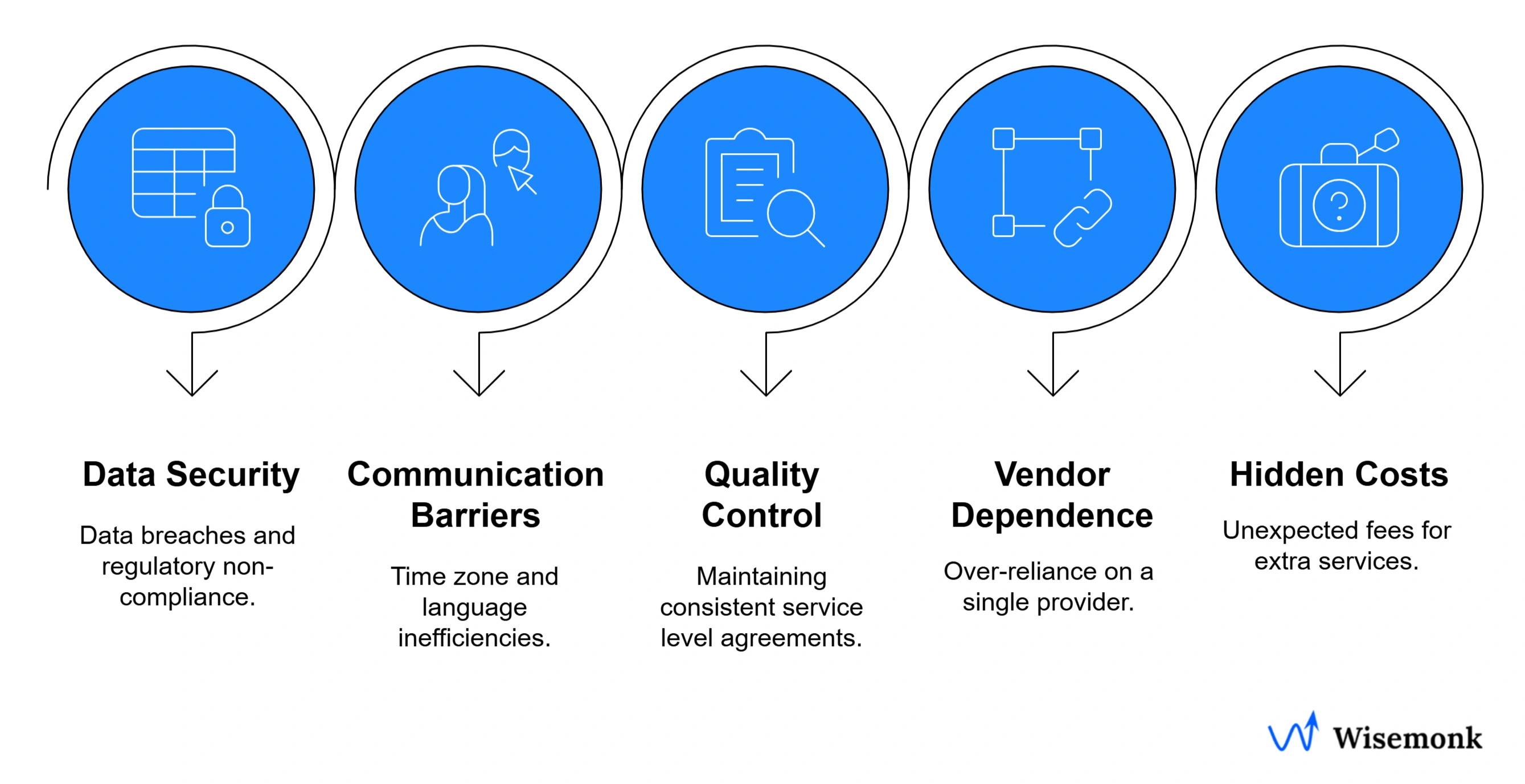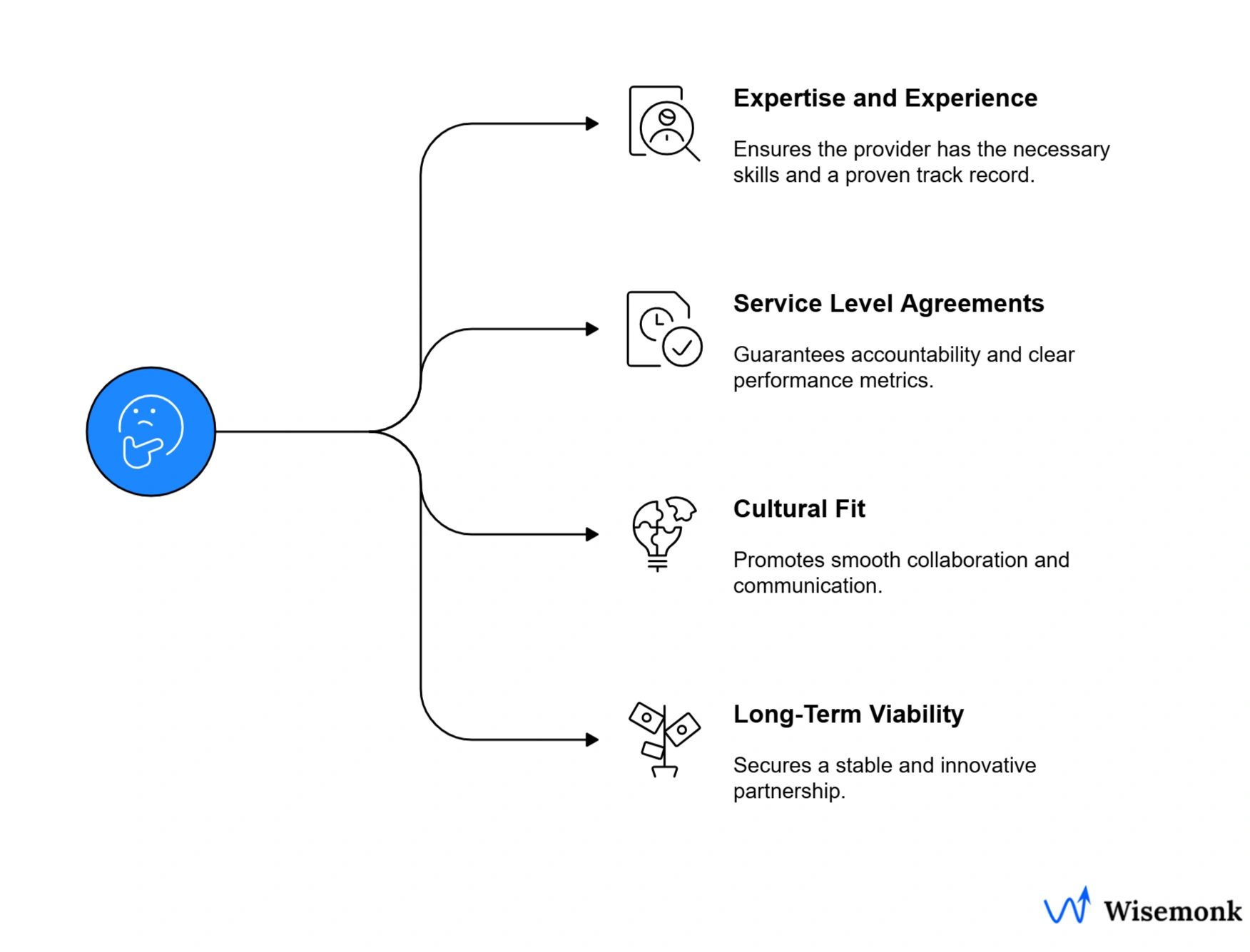- IT outsourcing is the practice of contracting third-party providers to manage IT functions such as software development, cloud services, and cybersecurity.
- Common IT services outsourced include software development, IT support, cloud services management, cybersecurity, infrastructure management, and data backup.
- Businesses choose IT outsourcing to reduce costs, access specialized expertise, scale quickly, and focus on core business functions while improving efficiency.
- Benefits of IT outsourcing include cost savings, access to global talent, enhanced security, scalability, and the ability to focus on core business growth.
- Steps involved in IT outsourcing include assessing IT needs, defining scope, researching providers, evaluating proposals, negotiating contracts, and onboarding the outsourced team for smooth integration.
Need help with your global expansion? Contact our team!
Discover how Wisemonk creates impactful and reliable content.
Looking to leverage IT outsourcing to improve efficiency and reduce operational costs? IT outsourcing might be the solution you're searching for. By partnering with third-party providers, businesses can leverage specialized expertise and scale their IT operations more flexibly. Whether you're a startup, a growing company, or an established enterprise, outsourcing IT services can unlock significant advantages. In this guide, we’ll explore the key benefits, challenges, and considerations of IT outsourcing, and help you understand how it can drive business growth.
What is IT outsourcing?[toc=What is IT Outsourcing]
IT outsourcing is the practice of contracting third-party providers to manage certain IT functions or entire IT departments. This approach allows businesses to access specialized expertise, reduce operational costs, and scale their IT operations more flexibly.
In our experience, we've seen numerous companies leverage IT outsourcing to enhance their technological capabilities without the need for extensive in-house teams.
Common IT functions to outsource:
- Software Development: Outsourcing the creation and maintenance of applications, websites, and mobile apps.
- IT Support and Help Desk: Providing technical assistance to employees or customers, often on a 24/7 basis.
- Cybersecurity: Implementing measures to protect systems and data from cyber threats.
- Cloud Services Management: Managing cloud infrastructure and services to ensure scalability and reliability.
- Infrastructure Management: Overseeing servers, networks, and storage systems to maintain optimal performance.
- Data Backup and Recovery: Ensuring business continuity by safeguarding critical data against loss or corruption.
These functions are commonly outsourced to specialized providers who bring deep technical skills and industry knowledge, enabling businesses to focus on their core competencies while ensuring robust IT operations.
To learn more about what outsourcing is, refer to out article on Understanding What Outsourcing Is and How it Works?
Why do businesses outsource IT services?[toc=Why Businesses Outsource]
Companies choose IT outsourcing to reduce operational costs, access specialized expertise, and improve efficiency without expanding internal IT teams. By relying on experienced outsourcing providers, businesses can scale faster, minimize risks, and stay competitive in a rapidly evolving tech landscape.
Based on our experience helping global companies design outsourcing strategies, we’ve seen that outsourcing services go far beyond just cost efficiency, they enable organizations to accelerate digital transformation and achieve long-term business goals through access to global talent and advanced technologies.
Key Reasons Businesses Outsource IT services:
- Cost Efficiency: Reduces hiring, training, and infrastructure expenses while converting fixed costs into variable ones.
- Access to Expertise: Leverages specialized providers with deep technical skills across IT services and emerging technologies.
- Focus on Core Business Functions: Allows internal teams to prioritize innovation and strategic growth over maintenance tasks.
- Scalability: Enables rapid expansion or downsizing of IT capacity based on business demand.
- Operational Efficiency: Outsourced IT services streamline workflows, improving productivity and service delivery speed.
- Risk Management: Experienced outsourcing partners ensure data security, business continuity, and compliance with global standards.
In short, many businesses outsource IT functions to achieve cost-effective solutions and accelerate business growth while maintaining control over strategic priorities.
What are the common IT outsourcing models?[toc=Different Models]
IT outsourcing models define how a business collaborates with an external provider, based on location, engagement type, or pricing. Each outsourcing model offers different levels of flexibility, control, and cost efficiency, depending on the company’s size and business goals.
From our research and experience guiding global businesses through outsourcing arrangements, we’ve seen that choosing the right model can directly impact project success, operational efficiency, and long-term scalability. Below are the key models most companies use when partnering with IT outsourcing firms.
Location-Based Models
- Onshore Outsourcing: Working with a service provider in the same country for easier communication and compliance alignment.
- Nearshore Outsourcing: Partnering with companies in nearby countries (similar time zones) to balance cost savings with collaboration convenience.
- Offshore Outsourcing: Engaging providers in distant countries to access global talent and achieve moderate cost savings at scale.
Relationship-Based Models
- Staff Augmentation: Supplementing your internal IT team with external specialists for short-term or niche projects.
- Project-Based Model: Hiring an outsourcing company to manage specific IT projects end-to-end, such as software development or network upgrades.
- Dedicated Team: Building a long-term, fully managed remote IT team integrated with your company’s operations.
Pricing-Based Models
- Fixed-Price Model: A clear budget for projects with defined scopes, ideal for predictable outcomes.
- Time and Material Model: Payment based on actual time and resources used, best for flexible projects.
- Subscription-Based Model: Recurring payments for ongoing IT services like infrastructure management or help desk support.
Each outsourcing model has significant advantages depending on your company’s needs, whether optimizing operational costs, scaling internal capacity, or accelerating digital transformation through access to specialized providers.
What are the key benefits of IT outsourcing?[toc=Key Benefits]
IT outsourcing helps businesses improve efficiency, cut costs, and access specialized expertise without the need to expand internal teams. By partnering with external providers, companies can quickly scale their IT operations and adopt advanced technologies.
Key Benefits of IT Outsourcing include:
- Cost Savings: Reduced operational costs, such as hiring and training, by leveraging external providers.
- Access to Specialized Expertise: Gain immediate access to professionals with deep technical skills in areas like cybersecurity, software development, and cloud management.
- Scalability and Flexibility: Easily scale IT services based on business needs, adapting to growth or market changes.
- Focus on Core Business Functions: Offload IT responsibilities to concentrate on core strategic initiatives.
- Enhanced Security: Utilize outsourcing partners with advanced security measures to protect data and ensure compliance.
In our experience, we've seen numerous businesses leverage IT outsourcing to not only reduce costs but also enhance their technological capabilities and focus on strategic initiatives.
These benefits highlight why many businesses choose IT outsourcing as a strategic move to stay competitive and agile in today's fast-paced digital landscape.
What are the challenges and risks of IT outsourcing?[toc=Challenges]
IT outsourcing offers significant benefits, but it also brings challenges and risks that businesses must carefully manage. These risks can include data security issues, communication barriers, and difficulties in maintaining quality control. Understanding these challenges is essential for businesses to make informed decisions and ensure a smooth outsourcing experience.
From our experience helping global businesses implement successful outsourcing strategies, we’ve seen that proactively addressing these challenges can minimize risks and foster long-term, productive relationships with outsourcing partners.
Key Challenges and Risks of IT Outsourcing:

- Data Security and Compliance Risks: Outsourcing often requires sharing sensitive company data with external providers. Without proper safeguards, this can expose the business to data breaches and non-compliance with industry regulations.
- Communication Barriers: Time zone differences, language discrepancies, and cultural differences can lead to delays, misunderstandings, and inefficient workflows.
- Quality Control Issues: Maintaining consistent service quality can be challenging when working with an external provider, especially without clear communication and well-established performance metrics.
- Vendor Management and Dependence: Over-reliance on a single outsourcing provider can create risks in case of disruptions, such as service interruptions or vendor bankruptcy, which could significantly impact business operations.
- Hidden Costs: Some outsourcing arrangements come with hidden fees for additional services or unforeseen changes in scope. It’s important to clearly define the contract and avoid unexpected costs.
To mitigate these risks, businesses should carefully vet potential providers, establish clear service-level agreements (SLAs), and maintain open and consistent communication throughout the partnership. This approach helps ensure that outsourcing relationships remain productive and aligned with business goals.
How to choose the right IT outsourcing partner?[toc=How to Choose]
Choosing the right IT outsourcing partner starts with evaluating expertise, reliability, and alignment with your business goals. A strong outsourcing company should demonstrate technical proficiency, proven experience, and a transparent approach to service delivery.
Key factors to consider when choosing an IT outsourcing partner:

- Assess Expertise and Experience: Review the provider’s track record, case studies, and domain-specific technical skills.
- Understand Service Level Agreements (SLAs): Define performance metrics, deliverables, and escalation protocols to ensure accountability.
- Evaluate Cultural Fit: Ensure smooth collaboration by aligning work ethics, communication styles, and time zone compatibility.
- Consider Long-Term Viability: Choose a financially stable outsourcing firm committed to innovation, continuous improvement, and long-term partnership.
Thoroughly evaluating these aspects ensures your outsourcing arrangement enhances operational efficiency, supports digital transformation, and aligns with your company’s strategic objectives.
How to get started with IT outsourcing? Step-by-Step Process[toc=Steps involved]
Getting started with IT outsourcing involves a structured approach, identifying your business needs, defining goals, and finding a reliable outsourcing partner. The key is to build a clear outsourcing strategy that aligns with your company’s technical requirements and long-term objectives.
Steps to Get Started with IT Outsourcing:
- Assess needs: Identify non-core IT services (e.g., software development, help desk, infrastructure management) that require specialized expertise beyond internal resources.
- Define scope: Write objectives, deliverables, timelines, KPIs, and success metrics tied to operational efficiency and cost savings.
- Choose a model: Select onshore/nearshore/offshore and engagement (staff augmentation, project, managed IT services) to match risk, control, and budget.
- Build a shortlist: Research outsourcing providers; review portfolios, client feedback, industry recognition, and domain fit.
- Issue RFPs & evaluate proposals: Compare pricing models (fixed, time & material, subscription), security practices, tech capabilities, and relevant case studies.
- Due diligence: Verify references, assess team composition and technical expertise, and confirm toolchains, compliance, and disaster recovery posture.
- Negotiate and contract: Finalize SLAs, data security controls, IP rights, confidentiality, acceptance criteria, and escalation paths with the outsourcing company.
- Onboard & manage: Set up access, tools, and knowledge transfer; run a pilot; establish cadence (standups, QBRs) and track service delivery against KPIs.
- Scale & optimize: Expand scope as outcomes are proven; refine the outsourcing arrangement to align with evolving business strategy and emerging technologies.
By following these steps, businesses can confidently outsource IT services, reduce operational costs, and leverage global talent to accelerate digital transformation while maintaining full control over outcomes.
What future trends will shape IT outsourcing?[toc=Future Trends]
Outsourcing is evolving, driven by artificial intelligence, cloud computing, advanced cybersecurity, and sustainable practices. These trends allow outsourcing companies to offer more value and flexibility, enabling businesses to stay competitive. Adopting emerging technologies is key to improving operational efficiency and scalability.
Based on our experience with global outsourcing providers, staying ahead of these trends ensures businesses can leverage IT outsourcing for cost-effective solutions while future-proofing their operations.
Key Future Trends in IT Outsourcing:
- Artificial Intelligence and Automation: Outsourcing firms are incorporating AI and automation to boost software development speed, reduce manual work, and enhance decision-making.
- Cloud Computing: Cloud platforms enable flexible, scalable outsourced IT services, optimizing costs and supporting digital transformation through multi-cloud and hybrid models.
- Cybersecurity Innovations: AI-driven threat detection and Zero-Trust frameworks are integral to securing outsourced IT operations, ensuring data protection and compliance.
- Sustainability Practices: Outsourcing companies are embracing eco-friendly infrastructure and renewable energy, aligning with global ESG goals while providing cost-effective solutions.
These trends highlight the shift towards more secure, scalable, and sustainable IT outsourcing models, enabling businesses to leverage cutting-edge technologies and specialized expertise.
How Wisemonk helps you deploy IT outsourcing successfully?[toc=How Wisemonk Helps]
Wisemonk is a leading Employer of Record (EOR) that enables global companies to hire, pay, and manage talent in India, without setting up a local entity. With deep knowledge of Indian employment laws, tax compliance, and cross-border workforce management, Wisemonk ensures your outsourcing strategy aligns with operational efficiency and global scaling.
Here’s how we assist in your IT outsourcing journey:
- We act as the legal employer for your global team in India, handling employment contracts, payroll, benefits, and compliance under local regulations.
- Hire and onboard top Indian talent in under a week, fully compliant with India’s labor and tax laws.
- We handle PF, ESI, gratuity, professional tax, and income tax filings to keep your team compliant year-round.
- Provide competitive and compliant benefits like health insurance, paid leave, and retirement plans tailored to Indian labor norms.
- Ensure new hires are productive from day one with laptops and IT setups delivered directly to their doorstep.
- Our HR experts manage day-to-day HR tasks, ensuring employee satisfaction and smooth operations.
While India is our core strength, we understand that many businesses have global ambitions. That’s why we also support clients expanding into key markets like the United Kingdom, the United States and beyond. With Wisemonk, you get a reliable partner for your India operations and your broader global hiring journey.
Ready to hire in India, quickly, compliantly, and confidently? Talk to our team today.
.webp)




.webp)
%20Companies%202026.webp)
